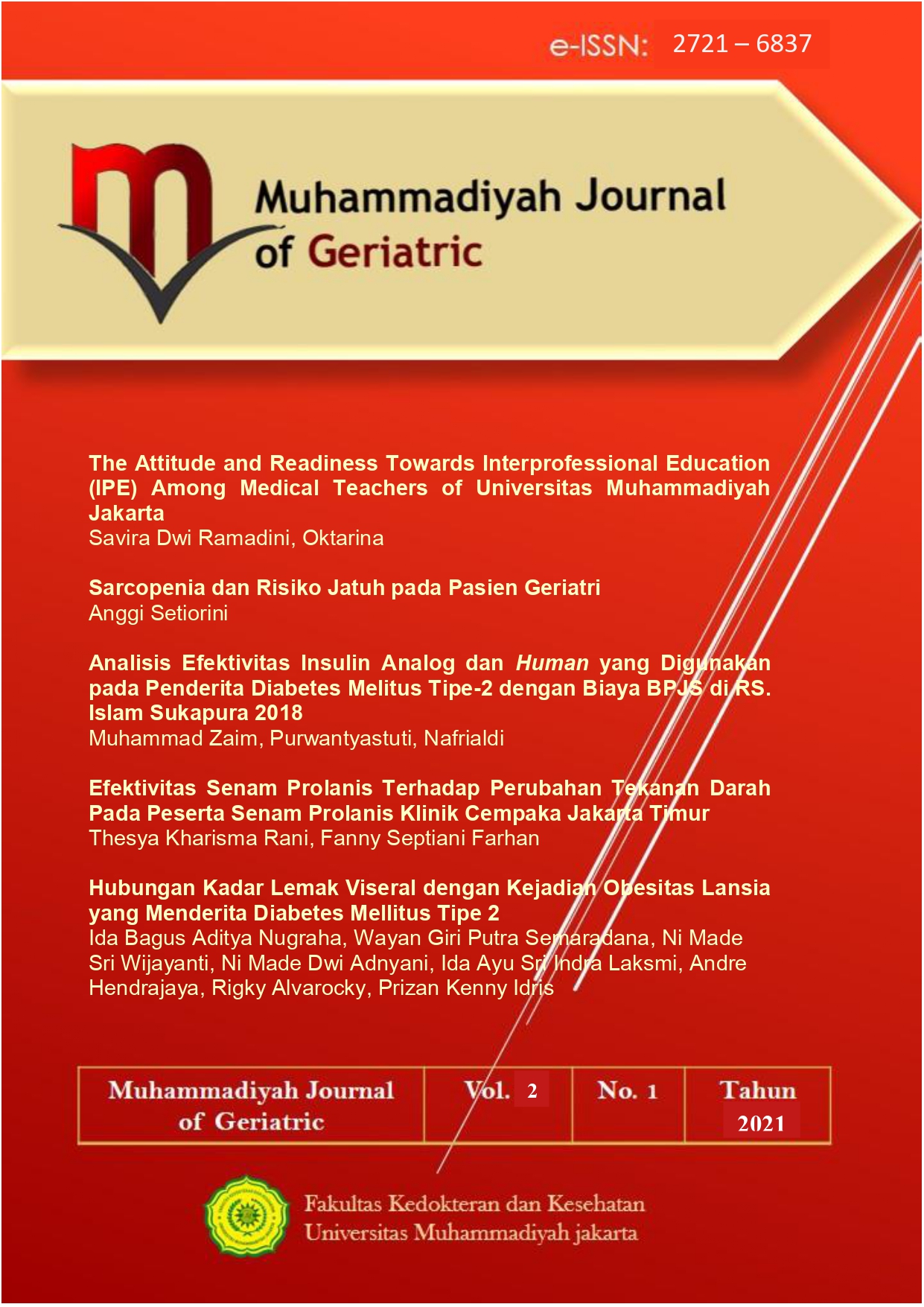The Attitude and Readiness Towards Interprofessional Education (IPE) Among Medical Teachers of Universitas Muhammadiyah Jakarta
DOI:
https://doi.org/10.24853/mujg.2.1.1-9Keywords:
attitude, interprofessional education, medical teacher, readinessAbstract
Background: Geriatric has multi-problems which need inter-disciplinary supports including collaboration among health professionals. To realize the importance of collaboration among health workers is to encourage collaboration since educational process. Teachers play an important role in conducting an Interprofessional Education (IPE). Purposes: To describe the attitudes and readiness of medical teachers of Universitas Muhammadiyah Jakarta (UMJ) towards IPE in 2019. Methods: The subjects of the study were medical teachers of UMJ with a sample size of 34 respondents. It was conducted at UMJ on November-December 2019. The instrument used for measuring the variable of attitude is the Attitudes toward Health Care Teams Scale (ATHCTS), whilst Readiness for Interprofessional Learning Scale (RIPLS) questionnaire was for the readiness. Results: It was found respondents who had attitudes in the good and fairly good categories were 62% and 38% respectively. Based on their state of readiness, 85% of the respondents were adequate, 15% moderate, and none not ready. Conclusion: Most of the respondents had a good attitude and ready for IPE. It was found that the aspects of the role in the team are mostly fairly good compared to aspects of values in the team and efficiency in the team which are mostly in the good category. The readiness showed adequate state in 2 aspects which are teamwork and collaboration and professional identity, whilst the aspect of role and responsibility was moderate. Consequently, improvement should be directed for the attitude to play a role in the team and the readiness in role and responsibility aspects.References
Yuniawan AE, Mulyono WA, Setiowati D. Persepsi dan Kesiapan Dosen Terhadap Pembelajaran Interprofesional. J Keperawatan Soedirman (The Soedirman J Nursing). 2015;2(1):17–23.
Bridges D, Davidson RA, Soule Odegard P, Maki I V., Tomkowiak J. Interprofessional collaboration: three best practice models of interprofessional education. Med Educ Online. 2011 Jan 8;16(1):6035.
Gilbert JHV, Yan J, Hoffman SJ. A WHO report: Framework for action on interprofessional education and collaborative practice. J Allied Health. 2010;39(SUPPL. 1):196–7.
Sulastien H, Syahrul S, Kadar KS. Pengembangan Attitudes Toward Health Care Teams Scale pada Kuliah Kerja Nyata Profesi Kesehatan. J Ilm Kesehat Keperawatan. 2018 Jun 1;14(2).
Situmorang T. Faktor-faktor Yang Berhubungan Dengan Persepsi dan Kesiapan Dosen Fakultas Kedokteran Universitas Diponegoro Terhadap Interprofessional Education (IPE). Universitas Diponegoro; 2018.
Patricia J, Bakri S, Adespin DA. Gambaran Persepsi Dan Kesiapan Dosen Fakultas Kedokteran Universitas Diponegoro Terhadap Interprofessional Education (IPE). J Kedokt Diponegoro. 2019;8(2):735–46.
Susanti D, Wulandari H, Juaeriah R, Dewi SP. Penerapan Interprofessional Education (IPE) pada Kelas Ibu Balita oleh Mahasiswa Tenaga Kesehatan untuk Meningkatkan Sikap Ibu terhadap Kesehatan Balita di Kota Cimahi. J Sist Kesehat. 2017 Dec 22;3(2):51–7.
Maria O, Lois R, Smego R. Interprofessional education: a concept analysis. Adv Med Educ Pract. 2010 Nov;1:75–84.
Greiner AC, Knebel E. Health Profession Education : A Bridge to Quality Washington (DC). Washington DC: National Academies Press (US); 2003.
Sedyowinarso M, Claramita M. Interprofessional Education (IPE), Communication and Interprofessional Teamwork. In: Prabandar i Y, Tetradewi FF, editors. Buku Acuan Umum CFHC-IPE. Yogyakarta: Universitas Gadjah Mada; 2014. p. 98–115.
Oandasan I, Reeves S. Key elements of interprofessional education. Part 2: Factors, processes and outcomes. J Interprof Care. 2005 May 6;19(sup1):39–48.
Canadian Interprofessional Health Collaborative (CIHC). Canadian Interprofessional Health Collaborative : Activities, outputs and impacts evaluation. Vancouver; 2009.
HPEQ-Project. Mahasiswa kesehatan harus tahu!: Berpartisipasi dan berkolaborasi dalam sistem pendidikan tinggi ilmu kesehatan. Jakarta: Dikti - Kementerian Pendidikan dan Kebudayaan; 2011.
Pfaff MA. Learning together: The image gently interprofessional simulation for nursing and allied health students. Teach Learn Nurs. 2014 Jul;9(3):108–14.
Sedyowinarso M, Fauziah F, Aryakhiyati N, Julica M, Sulistyowati E, Masriati F, et al. Persepsi dan Kesiapan Mahasiswa & Dosen Profesi Kesehatan terhadap Model Pembelajaran Pendidikan Interprofesi: Kajian Nasional Mahasiswa Ilmu Kesehatan. Dikti - Kementerian Pendidikan dan Kebudayaan; 2011.
Freeth D, Barr H, Barr H. Effective Interprofessional Education: Development, Delivery, and Evaluation. United Kingdom: Oxford: Blackwell Publishing; 2005.
Interprofessional Educational Collaborative, Practice IC, Values U. Core Competencies for Interprofessional Collaborative Practice: 2016 Update. 2016 p. 10–1.
Page RL, Hume AL, Trujillo JM, Leader WG, Vardeny O, Neuhauser MM, et al. Interprofessional Education: Principles and Application A Framework for Clinical Pharmacy. Pharmacotherapy. 2009 Jul;29 (7):879–879.
Gilbert J. Interprofessional Education for Collaborative, Patient-Centred Practice. Nurs Leadersh. 2005 May 15;18(2):32–8.
Downloads
Published
Issue
Section
License
Authors who publish in the Muhammadiyah Journal of Geriatric agree to the following terms:
- Authors retain copyright and grant Muhammadiyah Journal of Geriatric right of first publication with the work simultaneously licensed under a Creative Commons Attribution Licence that allows others to adapt (remix, transform, and build) upon the work non-commercially with an acknowledgement of the work's authorship and initial publication in Muhammadiyah Journal of Geriatric.
- Authors are permitted to share (copy and redistribute) the journal's published version of the work non-commercially (e.g., post it to an institutional repository or publish it in a book), with an acknowledgement of its initial publication in Muhammadiyah Journal of Geriatric.





3.jpg)

